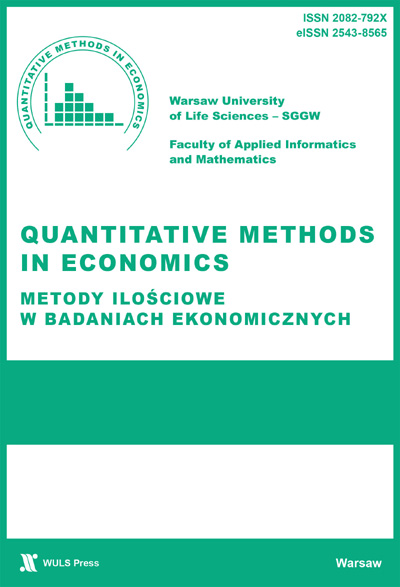Main Article Content
Using quarterly data for the 1998-2021 period, and with the application of Kalman filter estimates it is shown that the incomplete exchange rate pass-through (ERPT) is somewhat stronger for countries with a floating exchange rate regime, especially for producer prices. Since the middle of 2000s, the ERPT to consumer and producer prices for 11 Central and Eastern European (CEE) countries, as well as for the Baltic States, seems to be stable in most of the countries. With the exception of the Czech Republic, Romania, Estonia and Latvia, there is a tendency for strengthening of the ERPT to producer prices in the wake of the world financial crisis of 2008-2009.
Article Details
Aron J., Macdonald R., Muellbauer J. (2014) Exchange rate pass-through in developing and emerging markets: A survey of conceptual, methodological and policy issues, and selected empirical findings. Journal of Development Studies, 50(1), 101-143. (Crossref)
Baxa J., Šestořád T. (2019) The Czech exchange rate floor: Depreciation without inflation? Working Paper Series, 1/2019. Czech National Bank, Prague, the Czech Republic.
Ben Cheikh N., Ben Zaied Y. (2020) Revisiting the pass-through of exchange rate in the transition economies: New evidence from new EU member states. Journal of International Money and Finance, 100, 102093. (Crossref)
Bernini M., Tomasi C. (2015) Exchange rate pass-through and product heterogeneity: Does quality matter on the import side? European Economic Review, 77(C), 117-138. (Crossref)
Cunningham R., Friedrich C., Hess K., Kim M. J. (2017) Understanding the time variation in exchange rate pass-through to import prices. Staff Discussion Paper, 2017-12. Bank of Canada, Ottawa.
Darvas Z. (2013) Monetary transmission in three Central European economies: evidence from time-varying coefficient vector autoregressions. Empirics, 40(2), 363-390. (Crossref)
García-Schmidt M., García-Cicco J. (2020) Revisiting the exchange rate pass through: A general equilibrium perspective. Journal of International Economics, 127(C), 103389. (Crossref)
Gust C., Leduc S., Vigfusson R. (2010) Trade integration, competition, and the decline in exchange-rate pass-through. Journal of Monetary Economics, 57(3), 309-324. (Crossref)
Ha J., Stocker M., Yilmazkuday H. (2020) Inflation and exchange rate pass-through. Policy Research Working Paper, 8780. World Bank, Washington, DC. (Crossref)
Hajnal M., Molnár G., Várhegyi J. (2015) Exchange rate pass-through after the crisis: The Hungarian experience. MNB Occasional Papers, 121. Magyar Nemzeti Bank, Budapest, Hungary.
Jašová M., Moessner R., Takáts E. (2019) Exchange rate pass-through: What has changed since the crisis? International Journal of Central Banking, 15(3), 27-58.
Jimborean R. (2013) The exchange rate pass-through in the new EU member States. Economic Systems, 37(2), 302-329. (Crossref)
Kurtović S., Šehić–Kršlak S., Halili B., Maxhuni N. (2018) Exchange rate pass-through into import prices of Croatia. Exchange Rate Pass-Through into Import Prices of Croatia. Naše Gospodarstvo/Our Economy, 64(4), 60-73. (Crossref)
López-Villavicencio A., Mignon V. (2017) Exchange rate pass-through in emerging countries: Do the inflation environment, monetary policy regime and central bank behavior matter? Journal of International Money and Finance, 79(C), 20-38. (Crossref)
Mirdala R. (2014) Exchange rate pass-through to consumer prices in the European transition economies. Procedia Economics and Finance, 12, 428-436. (Crossref)
Ozkan I., Erden L. (2015) Time-varying nature and macroeconomic determinants of exchange rate pass-through. International Review of Economics and Finance, 38(C), 56-66. (Crossref)
Patra M. D., Khundrakpam J. K., John J. (2020) Exchange Rate Pass-through in emerging economies. RBI Working Paper Series, 01/2020. Reserve Bank of India, Delhi, India.
Sekine T. (2006) Time-varying exchange rate pass-through: experiences of some industrial countries. BIS Working Papers, 22. Bank of International Settlements, Basel, Switzerland. (Crossref)
Sims C. A. (1982) Policy analysis with econometric models. Brookings Papers on Economic Activity, 13(1), 107-164. (Crossref)
Svensson L. (2000) Open-economy inflation targeting. Journal of International Economics, 50(1), 155-183. (Crossref)
Takhtamanova Y. (2010) Understanding changes in exchange rate pass-through. Journal of Macroeconomics, 32(4), 1118-1130. (Crossref)
Vonnák B. (2010) Risk premium shocks, monetary policy and exchange rate pass-through in the Czech Republic, Hungary and Poland. MNB Working Papers, 2010/1, Magyar Nemzeti Bank (Central Bank of Hungary), Budapest.
Downloads
- Victor Shevchuk, Roman Kopych, GERMAN FISCAL AUSTERITY EFFECTS ON INVESTMENTS AND EXPORTS IN THE CENTRAL AND EASTERN EUROPEAN COUNTRIES , Metody Ilościowe w Badaniach Ekonomicznych: Tom 18 Nr 1 (2017)
- Victor Shevchuk, DETERMINANTS OF THE DEMAND FOR INTERNATIONAL RESERVES IN UKRAINE. , Metody Ilościowe w Badaniach Ekonomicznych: Tom 16 Nr 2 (2015)
- Victor Shevchuk, SECTORAL MONEY SUPPLY EFFECTS IN UKRAINE , Metody Ilościowe w Badaniach Ekonomicznych: Tom 15 Nr 2 (2014)
- Victor Shevchuk, Cyclical Determinants of Regional House Prices in Poland , Metody Ilościowe w Badaniach Ekonomicznych: Tom 26 Nr 3 (2025)

Utwór dostępny jest na licencji Creative Commons Uznanie autorstwa – Użycie niekomercyjne 4.0 Międzynarodowe.
Publikowane artykuły dostępne są na warunkach Open Access na zasadach licencji Creative Commons CC BY-NC – do celów niekomercyjnych udostępnione materiały mogą być kopiowane, drukowane i rozpowszechniane. Autorzy ponoszą opłatę za opublikowanie artykułu.





